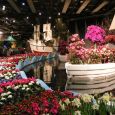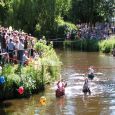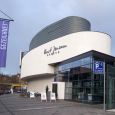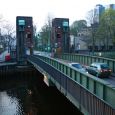Oldenburg
Advertisement
By Air
Because of its close proximity to the city of Bremen, the city is only about half an hour drive from the Bremen Airport.
By Train
The first railway line in the former Grand Duchy of Oldenburg, which was from the state capital to Bremen, on 15 July 1867 to traffic.On this route is one of the oldest moving railway bridges in Europe, the bascule bridge over the River Hunte.Immediately beside it is the former railway water tower that supplied steam engines with water.The Kingdom of Hanover, Oldenburg had been able to prevent a connection to the German railway network until 1866.The Kingdom of Prussia on the other hand, which had annexed the Kingdom of Hannover in 1866, turned a connection to the German Oldenburg's railway network is not in your way.
By Ferry
Oldenburg is connected to shipping through the Kustenkanal, a ship canal connecting the rivers Ems and Weser. With 1.6 million tons of goods annually, it is the most important non-coastal harbour in Lower Saxony.The port city of Oldenburg is connected via the Channel coast as inland waterway to the German inland waterway network. Oldenburg has continued Hunte Weser and also has a seaward entrance.The Hunte who is from the mouth of the Weser to Oldenburg to a waterway is navigable to Oldenburg for smaller ships.There is also a small port town. Oldenburg's not above the navigable Hunte offers beautiful trails for boating, as well as the mill at the edge of Hunte Castle Garden.
By Bus
From 1933 to 1985, the city traffic by the company in Oldenburg Oldenburg suburban trains Pekol performed GmbH, operational 1936-1957 several trolley buses.Private bus companies also offer 3 to 4 times daily trips to the Dutch Groningen (Public Express) and in the resin, to Berlin and in the Thuringian Forest (barrel-travel).
By Bicycle
The bicycle is the favorite means of transport in Oldenburg, whose city has a well developed network of bicycle paths accompanying.There are two bicycle stations at the station (at the central bus station and on the south side).They also do bike hire and purchase.In addition, Oldenburg and its environs offer a road network for bicycles, which offers specially along the river Hunte Hunte and the lowlands (a water catchment area for flooding) excursions for cyclists.
Oldenburg State Theatre
is the oldest theater in Oldenburg, Lower Saxony.The six-section theater in public ownership offers ideas of his own ensembles in music theater ( opera / operetta / musical ), drama, dance ( ballet ), concerts, children's and youth theater and Low German drama in cooperation with the August-Hinrichs-stage, the only plays in Low German language plays, as well as numerous guest appearances, readings, lectures and exhibitions.The main building houses the "Big House" with 827 seats. After a renovation in October 1989, one finds here also the little house with 350 seats. Since 2001, the games room, 70 seats comprehensive studio studio reactivated.During the 2010/2011 season, the big house is being renovated.As an alternative venue, the hall will shut down 10 of the air base Oldenburg used for this purpose, which was rebuilt and expanded.After the cultural needs of its citizens since the mid- 18th Century theater by guest appearances on ever-changing venues is satisfied, master carpenter Peter Hermann Wilhelm Muck began at the initiative of the Privy Councillor Christian Carl Ludwig Starklof to build a wooden structure built as a theater. The building stood close to the theater today and was financed from private funds.
National Museum of Nature and Man
is a nationally significant museum collection with the departments of archeology, natural history and ethnology.Focuses on the geology and archeology bog in northwest Germany.The Department of Natural History houses the permanent exhibitions, interdisciplinary Moor & Geest and coastal and marsh.Special exhibitions complete the program of the museum.In addition, the museum is the seat of EXAR, the European Association for the Advancement of Experimental Archeology Association, headed by the director of the museum, Mamoun Fansa is.The National Museum of Nature and Man in 1836 by Grand Duke Paul Friedrich August of Oldenburg opened as the Museum of Natural History.The collection comprised initially only prepared insects and birds.With the personal commitment of the Grand Duke's collection has been extended steadily, emphasis was to evaluate the local wildlife and a home science research, the center of Oldenburg.1867, the ethnographic collection, which integrates natural history and the Cabinet of Antiquities Collection from the Palace of the Duke in the museum.1880 a new building was needed to accommodate the increased collections.Since then, the museum moved to its present location.
Castle of Oldenburg
The Oldenburg castle stands on the site at which the Middle Ages to protect the crossing of the river Hunte an old water castle stood.The "Oldeburch" was first officially mentioned in 1108. Count Anton Gunther left the castle in the years 1607-1615 by the Mecklenburg architect Jurgen Reinhard in a Baroque castle converted.Which began around 1608 Comaske Andrea Spezza with the construction of a tower.This part of the castle is today the oldest section of the building and when Anton-Gunther-known tract.The castle is on three floors of the permanent exhibition "cultural history of a historic landscape" from the Middle Ages to the 20th Century presents. Here, the state rooms of the castle are included in the exhibition.
State Museum for Art and Cultural History
The castle in Oldenburg the former residence of Count Anton Gunther (1583-1667) and the Grand Dukes of Oldenburg to 1918/1919, is now a museum for art and cultural history.The permanent exhibition "Cultural History of an historic landscape," shows the diversity of cultural and historical specificity of the Oldenburg State over the centuries.Staterooms document the interior of the palace as the seat of the Grand Dukes of Oldenburg, whose residence history with the First World War came to an end.The former prince's palace ( Damm 1, 26135 Oldenburg at the dam serves as an exhibition house for the art of the 19th and 20 Century.On two floors, the development of fine arts in Germany is made clear, beginning with the romance and the art of classicism.Focus of the collection are the German Impressionism and expressionism of the bridge-painter, as is the work of the painter Dangaster Franz Radziwill (1895-1985).
Castle Garden
is a 18 acre public park in Oldenburg, located in the castle garden district, between the district Eversten and downtown.Right through the palace gardens of the region 130 km long trail runs " Jadeweg "(with a white" Y "on a black background labeled) in Wilhelmshaven, and begins in Wildeshausen ends.The Oldenburg Castle Garden is a historic park in the style of the English landscape garden.In the period 1804 to 1819 on behalf of Duke Peter Friedrich Ludwig of Oldenburg by the then gardener Julius Friedrich Wilhelm Bosse created.Atypical for an English landscape garden is the lack of Staffagebauten ( temples, ruins, architecture or chinoiserie ).Possibly this discrepancy is explained by the fact that bosses and his successors over the aesthetic design Humphry Repton followed.
Donnerschwee Stadium
is a former football stadium in Oldenburg, on the corner of Donnerschweer was Wehde street and road.It was called Hell of the North.The stadium was originally from Donnerschweer Oldenburg cycling club in 1884 as a velodrome built.The course was well suited for it, since that is already on the sand Oldenburg station was demolished and it was thus favorable conditions for the installation of the cliffs.Over the years, several investors have failed redevelopment plans for the fallow. End of 2005 indicated the first time a success for a plan to cultivate the land to a shopping center of 3000 square meters of sales area together with associated parking. Since 25 September 2008 are located on the former site of a discount supermarket and a stadium as a "community center Donnerschweer" titled multi-purpose building with offices, a bank branch, a pastry shop / cafe, a pharmacy and a supermarket.The latest plans are in the vicinity of the old stadium Donnerschwee the Maastricht Road (next to the EWE-Arena build) a new football stadium. This stadium will have a capacity of around 15,000 spectators, the stadium construction costs, according to the initiative "goole" at around 25 million euros.
City Festival Oldenburg
is one of more than 300,000 visitors over three days of the largest events of its kind in North West Germany.The large open-air party in Oldenburg in the middle of the city traditionally begins on the last Thursday in August and runs for three days.The origins of the City Festival 1975 in Oldenburg hair street to mark the inauguration of the pedestrian zone.Gradually, the stalls then spread over the whole pedestrian zone.Today there are about 20 stages (mostly with live music) and 250 stalls selling all kinds Its development owes largely to the city of Oldenburg hard Klaus Enke, who took over in 1975 as a spokesman for the street community organization and it later led to his event agency.Since summer 2004, the feast of the Oldenburg Event Marketing Agency E & M GmbH is held.
Information not available






